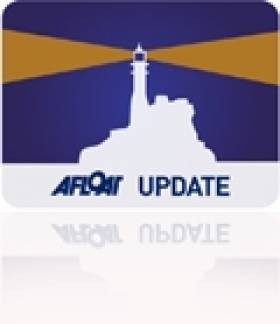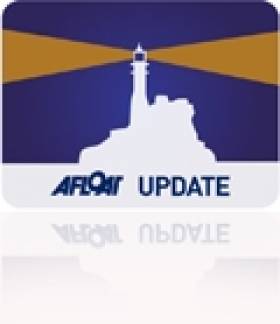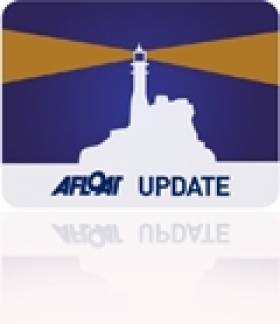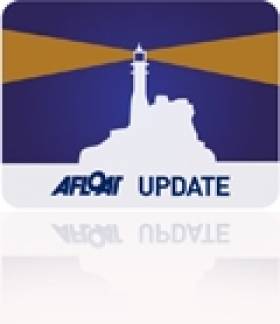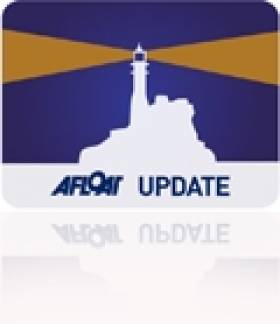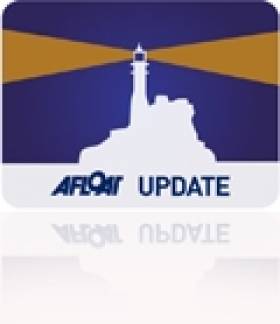Displaying items by tag: Fastnet
Spindrift 2 Multihull is Fastnet Race Line Honours Winner
#fastnet – Dona Bertarelli and Yann Guichard, co-skippers of Spindrift 2, a VPLP 131 Trimaran racing in the Multihull Division, crossed the finish line of the 2013 Rolex Fastnet Race at the Plymouth Breakwater at 02.53.58 BST on Tuesday 13th August after an elapsed time of 38hr 53m 58s.
It was a fiercly fought battle at close quarters right down to the wire against Spindrift 2's main rival, the maxi Trimaran Banque Populaire VII.
At 14:03 BST Dona Bertarelli and Yann Guichard's 131-ft Maxi Trimaran Spindrift 2 was the first boat to round the Fastnet Rock, the symbolic halfway point of the 611-nautical mile Rolex Fastnet Race.
Spindrift 2 rounded the Rock on the south-western tip of Ireland mere seconds ahead of the Armel le Cleac'h-skippered Banque Populaire as the two multihulls enjoyed a intriguing tactical tussle, attacking the final approach to the Rock from opposite directions. The speed machines are currently engaged in a gripping duel to the finish in Plymouth. At 17:00 BST Spindrift 2 retained a narrow lead, travelling at a consistent 30 knots some 200-nm from the finish. The arrival of the first multihull is expected in the early hours of Tuesday morning.
As forecast, Esimit Europa 2 has assumed leadership of the monohull fleet. The 100-ft Maxi guided by Jochen Schümann moved ahead at 19:30 BST on the first evening having taken time to force her way through the fleet after starting in the final group. She is expected to reach the Fastnet Rock later this evening. Her nearest rival on the water is Mike Slade's two-time line honours winner ICAP Leopard with the two Volvo 70s Team SCA (SWE) and Abu Dhabi Ocean Racing (UAE) stacked narrowly behind.
Niklas Zennström's Rán 2 (GBR), in pursuit of a third straight overall Rolex Fastnet Race victory, is currently second best in the duel with fellow 72-ft Mini Maxi Bella Mente. At 17:00 BST, Hap Fauth's American crew had created a 5-nm gap between the boats still some 360-nm from the finish. With the light conditions forecast for the continuation of the race, a third win for Zennström is in the balance. Despite the intensity of the contest, there was still time for some humour from the Bella Mente crew: "We seem to be an enjoying an English summer: overcast, upwind and cold!"
The bulk of the fleet is clustered on the approach to Land's End facing a second tactically demanding night at sea as they make slow progress to the Rock. Of the 336 race starters, seven have retired, the most high profile being the Maxi multihull Prince De Bretagne who reported a technical failure.
The atmosphere on the water at the finish was likened to a match race. The whole teams nerves and strength were tested to the last. It was a moment of satisfaction and relaxation when the cannon sounded as the maxi crossed the finish line, only a few seconds ahead of the blue trimaran. The 605 nm course, starting in Cowes , rounding the Fastnet rock and finishing in Plymouth Sound, was completed in 38 hours 53 minutes and 58 seconds.
Yann Guichard, co-skipper of the Maxi Spindrift 2 «The decisive moment of the race was here at the finish. We were in close contact throughout the race with Banque Populaire VII. In the Irish sea there was a time where they were ahead of us. Everything, as usual, played out in the last two miles, where we were very anxious because of the light conditions.. This race is a sprint. You have to be on the ball from start to finish, and that is what makes this race special. Every went really well onboard, everyone remained focused on their objectives, and Xavier Revil prepared good freeze-dried meal for the crew.. We managed two weeks of solid training since the launch of the boat. We are very proud and happy to win this Rolex Fastnet race! ».
No less than 340 boats remain on the course this evening..... Launched just over a month ago, this is the first victory in the colours of Spindrift racing for the trimaran. It is a good sign of things to come for Spindrift 2's projects and objectives and that of her crew. The giant of offshore racing will be on Standby from the beginning of October for the Route de La Decouverte. (Cadiz to Sansalvadour). Her first world record attempt.
The crew on the maxi Spindrift 2 for the Rolex Fastnet :
Dona Bertarelli – Skipper
Yann Guichard – Skipper
Xavier Revil
Erwan Tabarly
Antoine Carraz
Christophe Espagnon
Nicolas Texier
Jean Baptiste le Vaillant
Thierry Douillard
Sébastien Marsset
Thomas Rouxel
François Morvan
Simone Gaeta
Erwan Israel
Earlier report from the race course:
With the wind resolutely in the northwest, the leading monohulls are hard on the wind as they head out west across the Celtic Sea. The Jochen Schuemann-skippered Esimit Europa 2 continues to lead the on-the-water battle of the 100ft maxis from Mike Slade's ICAP Leopard, both boats soon to tack north. Given the wind direction, several boats have continued west while staying to the south of the Scillies. This includes the Baltic 78, Lupa of London, which remains ahead on handicap in IRC Canting Keel, followed by the two VO70s.
In this particular match race, the women's Volvo Ocean Race team on Team SCA has managed to stay ahead of the Ian Walker-skippered Abu Dhabi Ocean Racing, since passing them at Start Point.
"It was a night full of tacks and sail changes," reported Team SCA's Sam Davies. "It has been physically hard work, but our training is paying off and we have done some nice manoeuvres." Directly upwind, Team SCA's ETA at the Fastnet Rock is not until 0400 BST tomorrow, as the gradient wind is getting lighter and with the wind from the northwest the Fastnet Rock is effectively in the lee of Ireland.
Davies reckoned that she had had one hour's sleep last night, although as navigator she is not part of the watch system. Unusually, as the VO70s are racing this year under IRC, the crew is not allowed to stack the sails and so there has been more emphasis on the crew sitting on the rail.
The Mini-Maxi competition in IRC Zero continues with both American Hap Fauth's Bella Mente and Niklas Zennstrom's Ran 2 both also heading west, waiting to tack north, but with Bella Mente now five miles ahead of her rival. Since this morning, the US Mini Maxi, with a crew that includes Volvo Ocean Race winning skipper Mike Sanderson and Northern Irish navigator Ian Moore, has taken the lead in IRC Zero
Foxall Rounds Fastnet Rock as Multihull Leader
#fastnet – An intriguing dust-up is taking place between the world's fastest racing yachts competing in the Rolex Fastnet Race.
After an excellent start, the 40m trimaran, Spindrift 2, led the Multihull division along the south coast of England last night, but earlier this morning off Land's End it was the Damian Foxall crewed MOD70, Oman Air-Musandam, that had moved into the first place, despite being half Spindrift's length. Crossing the Celtic Sea, it was then the turn of the 31.5m trimaran, Banque Populaire, to edge ahead. But at the Fastnet Rock, Spindrift 2, just managed to get her nose in front, rounding at 14.03:08 BST with the Armel le Cleac'h skippered Banque Populaire right on her transom.
"It is a great match," enthused Spindrift 2's co-skipper, Yann Guichard, this afternoon. "Right now, Banque Populaire is just 300m to windward and we are doing the same speed and the same angle."
In theory the bigger boat should be faster, but Guichard says that in the 18-19 knot winds they have, the smaller Banque Populaire benefits from being lighter. "We are too heavy, so it is really close. We gybed first and she gybed just to windward, so it is like a match race - it is definitely not over yet."
Now she's cracked off, Spindrift 2 is making 35-36 knots of boat speed with an ETA into Plymouth of 02:30 BST tomorrow morning. Sadly as there has been less reaching this year, this will be substantially outside of her 32 hour 48 minute race record which this boat set two years ago.
With the wind resolutely in the northwest, the leading monohulls are hard on the wind as they head out west across the Celtic Sea. The Jochen Schuemann-skippered Esimit Europa 2 continues to lead the on-the-water battle of the 100ft maxis from Mike Slade's ICAP Leopard, both boats soon to tack north. Given the wind direction, several boats have continued west while staying to the south of the Scillies. This includes the Baltic 78, Lupa of London, which remains ahead on handicap in IRC Canting Keel, followed by the two VO70s.
In this particular match race, the women's Volvo Ocean Race team on Team SCA has managed to stay ahead of the Ian Walker-skippered Abu Dhabi Ocean Racing, since passing them at Start Point.
"It was a night full of tacks and sail changes," reported Team SCA's Sam Davies. "It has been physically hard work, but our training is paying off and we have done some nice manoeuvres." Directly upwind, Team SCA's ETA at the Fastnet Rock is not until 0400 BST tomorrow, as the gradient wind is getting lighter and with the wind from the northwest the Fastnet Rock is effectively in the lee of Ireland.
Davies reckoned that she had had one hour's sleep last night, although as navigator she is not part of the watch system. Unusually, as the VO70s are racing this year under IRC, the crew is not allowed to stack the sails and so there has been more emphasis on the crew sitting on the rail.
The Mini-Maxi competition in IRC Zero continues with both American Hap Fauth's Bella Mente and Niklas Zennström's Rán both also heading west, waiting to tack north, but with Bella Mente now five miles ahead of her rival. Since this morning, the US Mini Maxi, with a crew that includes Volvo Ocean Race winning skipper Mike Sanderson and Northern Irish navigator Ian Moore, has taken the lead in IRC Zero.
The French onslaught continues
French boats still dominate the smaller IRC classes. Nicolas Loday and Jean Claude Nicoleau's Grand Soleil 43, Codiam, continues to lead IRC One, but in IRC Two it is Samuel Prietz's A-40, Vitaris, that has taken over from Nutmeg IV since this morning. At present there is the unusual situation where the leader in IRC Two is ahead of the leader in IRC One, both boats now due south of the Traffic Separation Scheme off Land's End.
At tea time the Discover Ireland entry Aodhan Fitzgerald skippered boat sent the following update: Just arrived at scillies now after glorius days sailing. Going north of scillies and the close to rhumb line for fastnet. Fleet tightly packed around us . Morale good. Sail repairs progressing well!
However the overall leader of the Rolex Fastnet Race under IRC rating has now passed on from the IRC Two leader to the IRC Three leader, still Jean Jacques Godet's J/120, Rhapsodie V, now lying six miles astern of Vitaris. Noel Racine's JPK 10.10, Foggy Dew, remains ahead in IRC Four, approaching the longitude of Land's End.
Currently lying seventh in Class 2 is Scarlet Oyster, whose skipper Ross Appleby reported that they hadn't had a great start yesterday, but had regained some ground since. "At Portland Bill we just sneaked through there before the tide shut us off as the breeze was a bit light." From their position just off the Lizard, Appleby said they were able to lay the south-west corner of the Traffic Separation Scheme just off Land's End.
Appleby was concerned by the weather ahead in the Celtic Sea with an area of high pressure forecast to encroach over the area tomorrow. This was leaving with him the decision of whether to sail directly towards the Rock in lighter conditions, anticipating a shift to the southwest, or to stay further east, in better breeze but sailing more miles. "It is a bit of a Catch 22," mused Appleby.
On board Scarlet Logic, despite being upwind since the start, the crew had managed to get some sleep in last night. "It is quite comfortable on deck. The stand-by guys have been able to sleep on the rail a bit. It wasn't too wet."
Meanwhile the Rolex Fastnet Race Village in Plymouth Yacht Haven is beginning to fill up with press, friends and relatives of crew, waiting for the boats to start arriving.
Fastnet Race Lead for NI Yacht Spirit of Jacana in Class One
#fastnet – Bruce Douglas and Alan Bruce's Spirit of Jacana is vying for the overall lead in class one of the Fastnet race this lunchtime but snake and ladder conditions are keeping crews on their toes and praying for pressure, 24 hours into the classic offshore race. The Northern Ireland based J133 from Carrickfergus was lying fifth overall in the 335–boat fleet and leads Irish hopes as both Ker 39s Antix and Inismor dropped back briefly. There are over 475 miles still to go with everything to play. Places have been changing dramatically on the race tracker with every update this morning. Despite having been upwind since the start, the Rolex Fastnet Race fleet has been making excellent progress down the south coast of the UK since yesterday's start.
Discover ireland skipper Aodhan Fitzgerald sent an up date to Afloat.ie this lunchtime: '17th in class 27th overall. Just approaching lizard. We blew out our genoa in 27kts squall at 11am. So are frantically trying to repair. Bit slow now under non overlapping headsail. Beautiful day dry boat for a change and some great grub being produced. Praying for pressure to the rock now!'
There have been no retirements overnight, and to date, just four boats from 335 starters have officially dropped out. The most dramatic was the grounding of the brand new Cayman Islands-registered Botin 65, Caro, which went hard onto Salt Mead Ledge at the top of the tide yesterday afternoon. She has since been pulled off but has been forced to retire back to Endeavour Quay in Gosport.
The Clipper 68, New York, retired after suffering a fire on board and didn't make the start. The Farr 52, Toe in the Water, withdrew yesterday afternoon when a winch pulled out of her deck. The Royal Navy Nicholson 55, Dasher, is also out after another boat collided with her.
At 0130 BST this morning, Sidney Gavignet's crew on board the Oman Air-Musandam MOD70 trimaran led the substantially larger Armel le Cleac'h-skippered Banque Populaire past Land's End, hugging the shore this morning. Dona Bertarelli and Yann Guichard's even larger 40m long Spindrift 2 chose a different route to the west, only tacking north once they were south of the Scilly Isles. The lead trio remains close with the Omani MOD70 a nose ahead.
"The sea is quite choppy so it is not easy," said Dona Bertarelli. "It makes for a lot of work on the deck for the team to trim the sails and to keep up a good speed in these short waves. During the night we had less wind near the Scilly Isles, which has been really bad for the speed of Spindrift 2. So our friends on the other multihulls have gained ground on us and now a new fight begins to reach the Fastnet in first position."
Mike Slade's Farr 100, ICAP Leopard, continues to hang on to the coat tails of the monohull front runner, the Gazprom-backed European maxi, Esimit Europa 2. Both are passing west of the traffic separate scheme (TSS) at Longships off Land's End, with Leopard just four miles astern of her rival. But on handicap it is the Baltic 78, Lupa of London, that leads IRC Canting Keel.
Six miles behind Leopard, and approaching the TSS, is Team SCA, which, in the on-going Volvo Open 70 match race, overtook Ian Walker's team on Abu Dhabi Ocean Racing off Start Point at 2300 BST last night.
"We had a park up at Start Point which turned our race inside out," Walker reported. "We had tide against and we went off wider, hoping to carry some wind round, worried about getting stuck under the cliffs. Unfortunately everyone else just sent it right in under the cliffs and ghosted through while we got stuck. We lost about 5-6 miles to the girls and to some of the Open 60s and Bella Mente. We made a few gains back and then had a big fish on the rudder. That took about 20 minutes to clear off the port rudder. Other than that it is going alright."
Walker reported that off the TSS they currently have 16 knots from the north-west (although they had seen as much as 20 knots) and they had just decided to follow the leaders up the western end of the TSS.
A similar match race is going on just between the 72ft Judel Vrolijk Mini Maxis. 3.5 miles behind the Abu Dhabi VO70 and having just passed the longitude of Land's End, American Hap Fauth's Bella Mente is just over three miles ahead of her older rival, Niklas Zennstrom's Rán 2, the Rolex Fastnet Race defending champion. The bulk of IRC Zero is due south of the Lizard, including the IRC Zero leader on handicap, the Russian team on the Swan 60, Bronenosec, skippered by Vladimir Liubomirov.
After passing Portland Bill yesterday evening, the IRC Zero fleet, en masse, dug into Lyme Bay, but since passing Start Point has pushed south of the rhumb line to the Lizard.
One of the most impressive performances in the race continues to be that of Vendée Globe winners François Gabart and Michel Desjoyeaux, who are leading the IMOCA 60 class aboard the former's MACIF. Despite being 12ft shorter and being sailed doublehanded, MACIF is lying between the Mini Maxis on the water.
Behind, once again French boats are dominating all of the remaining classes on handicap. Overall IRC leader at present is François Lognone's J/122, Nutmeg IV, also front runner in IRC Two. She is shortly to pass the Lizard and is right on the coat tails of the IRC One leader, Nicolas Loday and Jean Claude Nicoleau's Grand Soleil 43, Codiam, second overall under IRC. Both boats are past competitors in French teams contesting the Brewin Dolphin Commodores' Cup. The bulk of IRC One and Two is at present due south of Plymouth.
The IRC One boats were forced to shave Portland Bill last night to keep out of the worst of the tide with Piet Vroon's Ker 46, Tonnerre de Breskens, continuing to lead the charge on the water, passing Start Point at around 0230 BST.
Jean Jacques Godet's J/120, Rhapsodie V, is ahead in IRC 3, close to the rhumb line between Start Point and the Lizard, while around five miles behind on the water, Noel Racine's JPK 10.10, Foggy Dew, is leading IRC Four.
Irish Sisterships Antix, Inismor in top Five in Fastnet Race
#Fastnet – After the first night at sea in the 2013 Fastnet race, two of 12 Irish yachts are showing the potency of Irish offshore sailing with top five performances in the 335–boat fleet. Clidfen Boat Club's Inismor sailed by the French Guoy brotherrs are lying fourth and Royal Cork's Anthony O'Leary in Irish champion yacht Antix lies fifth. Both boats are Ker39 designs with a proven offshore performance capability. Inismor is the current Round Ireland champion.
The 335 competing boats still have over 475 nautical miles to go in this offshore challenge from Cowes to the Fastnet rock and back but already the signs look like a rerun of May's Myth of Malham race for the top Irish boats. So far Chris Tibbs weather forecast is being borne out on the race track and this will favour the 35-40– foot boats.
Read WM Nixon's Fastnet Yacht Race preview on the Irish entries here.
Currently lying 25th overall, skipper Aodhan Fitgerald reported from Discover Ireland at 02.25 this morning: 'Light winds now as we approach start point. We are amongst the northern most in our class so recent knock may pay dividends. Beautiful moon and star lit night off south coast uk. Very comfortable with dry decks which is nice but doesn't suit us! All well otherwise had some fun getting around Portland bill in the inner channel'.
Fastnet race tracker here:
Fastnet Yacht Race Tracker Here!
#Fastnet – Yachts in the Rolex Fastnet Race are off! They're heading for Ireland and the Fastnet rock off the Cork coast! Track all 335 boats here on the race tracker detailing all the times and handicap positions of the competitors as they progress on the 650–mile race.
Fastnet Forecast Favours Irish Boat Sizes
#fastnet – The current weather may suit up to a dozen Irish boats readying for the Fastnet race tomorrow that includes Irish IRC Zero champion Antix, in one of its first debuts offshore.
Fastnet Race meteorologist Chris Tibbs says with the forecast as it is at present, Chris Tibbs believes that favourite for this year's race could be among the 35-40 footers.
Weather is currently at the forefront of competitors' minds as this will dictate their fortunes over the next few days.
Significantly many of the Irish boats competing fit in to the 35-40 foot category, including former Afloat sailor of the year Antony O'Leary's 39-foot Ker design.
Typically the forecast benefits either the big boats or the small boats, but this year, Tibbs says it is far from clear whether either will come out on top.
Irish boats or boats of Irish interest in the 300– boat fleet heading west include a core of Irish Sea Offshore racers (ISORA) and Round Ireland winners including Dutch and French boats: Adelie (First 34.7, Peter Hall, NYC), Alchimiste (JPK 9.60, Mike Murphy, KYC), Antix (Ker 39, Anthony O'Leary, RCYC), Figaro II (Figaro, David Kenefick RCYC), Diablo-J (J/105, Nick Martin/Andy Boyle, RORC), Inis, Mor (Ker 39, Laurent Gouy, Clifden BC),, Jedi (J/109, Andrew Sarratt, Dun Laoghaire), Joker (J/109, Chris Andrews, Dun Laoghaire), Lula Belle (First 36.7, Liam Coyne, NYC) Lynx Clipper/The Gathering (Reflex 38, Aodhan Fitzgerald, GBSC),, Raging Bull (Sigma 400, Matt Davis, Skerries SC), Spirit of Jacana (J/133, Alan, Bruce & James Douglas, Carrickfergus SC., Tonnere de Breskens (Ker 46, Piet Vroon, RORC)
According to Tibbs, the start and first stage to St Alban's Head will be in south-westerlies before the wind starts veering into the northwest, making for a starboard tack-biased beat down the coast of the UK. Significant for the bigger half of the fleet, is that the wind is currently forecast to stay in the north-west making for a full beat across the Celtic Sea to the Fastnet Rock and then a dead run back, with a broad reach on to the finish in Plymouth in relatively light breeze.
The wind only frees up for boats heading outbound to the Rock, when it backs into the west on Tuesday night/Wednesday morning. The slower boats, which won't be crossing the Celtic Sea outbound to the Rock until then, will be in for a fast reach across and back, but they may then get held up depending on the movement of a ridge of high pressure due to encroach into the mid-southern Channel area on Thursday.
French Armada
France is probably the world's top nation when it comes to offshore racing with events such as the singlehanded round the world race, the Vendée Globe, and classes like the IMOCA 60, Class40 and Figaro. In addition to their domination of many of the IRC classes, French boats also represent the majority in the non-IRC classes competing in this year's Rolex Fastnet Race, which sets sail from Cowes tomorrow from 12 noon BST.
This year's biennial race to Plymouth via the Fastnet Rock off southern Ireland, features some of the very best sailors from across the Channel, including Michel Desjoyeaux, PRB skipper Vincent Riou and François Gabart. Between them, they have won the last four Vendée Globe races. The podium finishers from the 2012-3 Vendée Globe are all taking part, with Gabart back on his winning IMOCA 60, MACIF, Alex Thomson on his third-placed Hugo Boss, while second placed Armel le Cleac'h, has graduated up to skipper of the 31.5m long trimaran, Banque Populaire.
Michel Desjoyeaux is the world's most successful shorthanded offshore sailor having twice won the Vendée Globe, and the prestigious La Solitaire du Figaro three times. This year's race, which he is sailing on MACIF with his protégé François Gabart, is only his second Rolex Fastnet Race but represents the 20th anniversary of his first - aboard the Whitbread maxi, La Poste.
Desjoyeaux says he first heard of the race when he was 14. "Two of my brothers were here with Half Tonners and they phoned home on the morning of the start and they said we're coming back to France because there was a big storm coming. That was in 1979..."
For François Gabart, this will be his first Rolex Fastnet Race, but he knows the course well and says he is pleased to be here because the hull of his IMOCA 60 was built at Green Marine in Hythe.
Rolex Fastnet Race. François Gabart. Credit: Paul Wyeth/pwpictures.com
"The Rolex Fastnet Race is one of the most famous offshore races. I wasn't born in 1979, but I heard a lot about it. I remember when I first sailed to the Fastnet Rock - it was something big," says Gabart. Since the Vendée Globe, MACIF has had her mast replaced and has her pre- Vendée sail wardrobe on board.
Eight IMOCA 60s are competing in this year's race, all of them being sailed doublehanded in preparation for this autumn's Transat Jacques Vabre.
For German Jörg Riechers this will not only be his first Rolex Fastnet Race, but also his first major race in his new IMOCA 60, mare, previously Michel Desjoyeaux's 2008 Vendée Globe winner. "When I was young I dreamed of doing the Admiral's Cup, which was strongly connected to the Rolex Fastnet Race. This is a classic race. You get the trimarans, the Open 60s and the Class40s and all the IRC boats. It is the gathering of the best boats in the world."
Seventeen boats are competing in the Class40. Unlike the IMOCA 60s, these are being sailed fully crewed. Among them the favourite is probably Sebastien Rogues on his Mach 40 EDF Suez, recent winner of the Les Sables-Azores-Les Sables race.
Again it is Rogues' first participation. "The Rolex Fastnet Race is a mythical race, like the Rolex Sydney Hobart. You have to do it at least once in your life. It has a long history, and there have been some very tough races. I am very honoured to be participating. It's a good race to see the level of competition before the Transat Jacques Vabre."
New Class40 models debut
his year's race marks the debut for two new models of Class40, with Spanish former World Champion Gonzalo Botin competing on Tales II, a new design from his Emirates Team New Zealand naval architect brother, Marcellino, while the Austrian-flagged Vaquita, is the latest Class40 from Tom Humphreys (son of Rob). Damien Seguin is also taking part on his new Akilaria RC3, Des Pieds Et Des Mains, which is so new that is has yet to measure and so is competing under IRC.
Interestingly aside from being Class40 skippers, both Seguin and Bruno Jourdren, skipper of Lord Jiminy, are also leading paralympic sailors - both silver medallists in Beijing, while Seguin won 2.4mR gold in Athens.
The turn-out in the smaller 32ft Figaro class is growing with a strong turn out from the Artemis Offshore Academy. The race is particularly special for Rockfish skipper Henry Bomby.
"The first time I sailed a Figaro was the Fastnet two years ago. That summer I got selected for the Academy. If I'd know then that in the next two years I would have done two Solitaire du Figaros and started to get my own sponsors, I would have been pretty happy."
His sponsor Rockfish, run by celebrity chef Mitch Tonks, has recently opened a new restaurant in Plymouth very close to where the Rolex Fastnet Race will moor at Plymouth Yacht Haven.
Most of the new recruits to the Artemis Offshore Academy are also competing in the Figaro class, while Sam Goodchild, the leading British finisher in this year's La Solitaire du Figaro, is competing in the Class40 aboard Peter Harding's 40 Degrees.
#fastnet – "The Gull was a plank-on-edge cutter of ancient vintage. She had a tremendous jackyard topsail, a terrific tiller, and a pack of wild Irish men aboard her, who flogged the life out of her. As I recall, we were either first or second around the Fastnet. Shortly thereafter the mainsail started letting go and water came up over the floor-boards because we'd spewed all our bow caulking. The glass dropped .80 inches in forty-five minutes, and on that came a regular Bristol Channel howler."
Thus is Harry Donegan of Cork and the Gull's involvement in the Fastnet remembered, in this opening to a piece of international sailing journalism written after the second Fastnet Race of 1926 by Warwick Tompkins. He was an American who was so keen to do this recently inaugurated challenge that he inveigled his way into Gull's crew by what was virtually a pierhead jump shortly before the start.
But he and his skipper and new shipmates hit it off well, and subsequently his own seafaring career blossomed with his thirty years of voyaging aboard the schooner Wander Bird recorded in print and on film. His family were raised totally afloat, such that one of his sons, Warwick Jnr, was a renowned sailor invariably known as Commodore Tompkins who commented that his life had been lived back to front. Most sailing enthusiasts learn how to live on boats as they mature into an appreciation of cruising and the voyaging life. But Commodore Tompkins eventually had to learn how to live ashore, even though he continued sailing.
However, the name of Tompkins first came to sailing prominence through his father's vivid picture of Harry Donegan and his crew of Corkmen in the Gull in 1926. It says much for the power of Warwick Snr's writing that his account has the ring of a greater truth to it, despite the fact that it has certain inescapable inaccuracies. And we can rightly consider such things this morning as today in Cowes, Jamie Donegan (22) - great-great-grandson of Harry Donegan - is making final preparations with his shipmates aboard Anthony O'Leary's Ker 39 Antix to race his first Rolex Fastnet Race, sailing as bowman.

Anthony O'Leary Ker 39 Antix Photo by Bob Bateman
With a record fleet of 380 boats tomorrow – including a turnout of twelve Irish boats – the early Fastnet Races with their modest fleets have now acquired an almost mythological status. Each detail is lovingly picked over and analysed every which way, while the continuing and healthy survival of Jolie Brise, the 1913-built pilot cutter which won the first race of 1925, is a matter of awe. This was seen last month in Glandore was she was the superstar of the Classic Boat Regatta in this her Centenary year, with her ceremonial rounding of the Fastnet Rock a quasi-religious event.

A very special event – the historic Jolie Brise, winner of the first Fastnet Race in 1925, approaches the Fastnet Rock in her Centenary Year during Glandore Classic Regatta last month. Photo: Brian Carlin
So what's the beef about old man Tompkins' Gull story? Simple enough. It's a slander on a fine yacht to describe her as "a plank-on-edge cutter of ancient vintage." She was no such thing. When Harry Donegan bought her in Cork Harbour in 1921, she was one of the shrewdest yacht-purchasing decisions ever seen about the place. For the handsome Gull had been designed in 1896 by the legendary Charles E Nicholson when he was aged 28, and starting to come into his prime as the greatest English yacht designer. Nicholson had been designing yachts of all sizes for construction by the family firm of Camper & Nicholson since at least 1892, and by 1896 he had moved very far indeed from the plumb bow, plank-on-edge leadmines of the 1880s.
With 10.1ft beam on her overall hull length of 44ft, many would have considered Gull quite beamy when she first appeared. But she did set a truly enormous gaff rig, and in order to hold it up the shrouds were given extra power by the chainplates being on channels to widen the angle. For stylish yachts in 1896, channels for the chainplates were rather old-fashioned, and for an American like Tomkins who associated such things with ancient working schooners, they gave a false impression of antiquity. But the fact is that at the time of the 1926 Fastnet, Gull was only thirty years old. Quite mature perhaps, but never "ancient vintage".
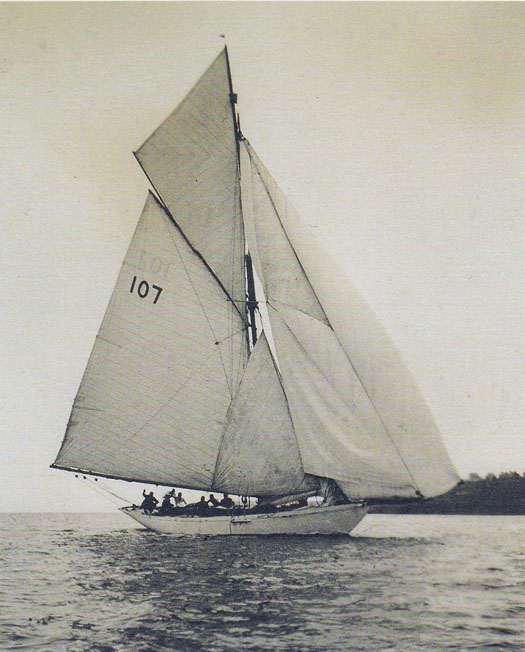
Gull in her prime. She was a fine creation by Charles E Nicholson when he was aged 28 in 1896, and beginning to make his mark as a major yacht designer. Photo courtesy Royal Cork YC.
Ironically, during the current Cowes Week, Jamie Donegan has been one of the "pack of wild Irishmen" sailing (and very successfully too) with Adam Gosling aboard the Corby 36 Yes!. Back in the day - and it's now quite a long time ago - the current Yes! was the ground-breaking Mustang Sally, first owned and campaigned with exceptional success by Peter Wilson of Howth. For many of us, Mustang Sally was and is the definitive Corby design, and it's great to see her today in superb order in loving ownership, and still in the frame. But the quite narrow Mustang Sally (as was) is now nearly twenty years old, comparable to Gull's age when Harry Donegan bought her when you also remember she'd been out of commission during the 14-18 War. Yet it would be absurd to describe Yes! as "a plank-on-edge sloop of ancient vintage".
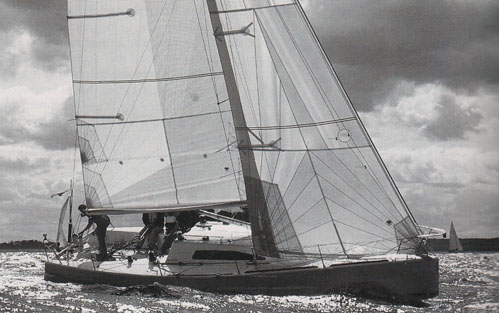
Mustang Sally in Peter Wilson's successful ownership. In June 1995 she won every race she entered, including (this photo) the Howth YC Centenary Regatta. Photo Rick Tomlinson/Courtesy HYC
That said, the huge rig on Gull took its toll which aged her before her time, and it gives us an excuse to run Warwick Tompkins' rollicking piece in full:
"The Gull was a plank-on-edge cutter of ancient vintage. She had a tremendous jackyard topsail, a terrific tiller, and a pack of wild Irish men aboard her, who flogged the life out of her. As I recall, we were either first or second around the Fastnet. Shortly thereafter the mainsail started letting go and water came up over the floor-boards because we'd spewed all our bow caulking. The glass dropped .80 inches in forty-five minutes and on that came a regular Bristol Channel howler.
In thick weather we groped for Baltimore, and when we got within what we estimated to be two miles and could not pick up the light, we reluctantly gave up the heroic idea of beaching the Gull there, caulking her, and still finishing. (Yes, that's the sort of Skipper and crew it was!) We hauled off to Queenstown (Cobh). We were close hauled under tri-sail and storm jib with the wind coming now from about the sou'east and the delightful Irish coast altogether too close under our lee.
The seas were breaching clean over the old packet, and the spitfire jib -- though we didn't know it—was pulling the runner eyebolt right out of the counter. We passed the Stag Rocks and they weren't more than two hundred yards to leeward; on the darkest, wildest sort of night they were plainly visible and audible, great and terrifying founts of spray just to leeward. It was possibly the closest escape I've ever had at sea and one of the few times my life has actually been in danger.
Well, the old bucket held together until we put her on the mud at Cobh in the morning. All hands had pumped bailed and cursed – I didn't hear any praying – all night long, and everything on board was soaked. When the mess was drying out in the sunlight this final morning I found my bedraggled, red-eyed, but still spunky little skipper fiddling around on deck with what looked to me suspiciously like a boy's toy. I asked him what he was doing, and his answer, s'helpmegawd, was:
"I'm flying a kite".
He went on to explain that he had meant to test out a theory that an aerial could best be carried by a kite when at sea, and so he had brought along a box-kite which he had forgotten until we started heaving gear on deck. Discovering it at this late date his intellectual curiosity remained strong enough to overcome the anxiety, desperate work and weariness of a rotten hard race and near-foundering. His name is Harry P.F. Donegan, a solicitor of Cork, and one of the world's best."
Corkmen will if course tell you that down Munster way, there's much more meaning to "flying a kite" than simply putting a toy aloft. And as for Harry Donegan being "one of the world's best", Warwick Tompkins had further reason for thinking so. In 1926, the only qualification for membership of the nascent but already prestigious Ocean Racing Club was completing a Fastnet Race. Harry Donegan and his crew were already members after coming third with Gull in the inaugural race the previous year. But that had been a relatively gentle affair, and Donegan reckoned that Tompkins was now every bit as qualified. So he gathered up the American, piled aboard the Cork-Swansea ferry that night with him, caught a series of trains to Plymouth next day, and that night at the post-Fastnet dinner, Donegan made an impassioned speech in support of Warwick Tompkins' right to RORC membership, which was carried with acclamation.

Harry Donegan aboard his beloved Gull
Harry Donegan (1870-1940) was in his way quite a force in sailing, and in the life of Cork and Ireland. A small man of notable energy, he was playing a key role in Cork Harbour sailing from an early age. When the plans for the new Cork Harbour One Designs were being discussed with William Fife in 1894-85, Donegan was secretary to the owners' group, and though he never owned a CHOD himself, he was renowned as helmsman in the class, and as an amateur painter he also recorded their earliest appearances.
But cruising and offshore sailing were his greatest passion, and he made some coastal ventures in very small craft. By 1912 he had produced pioneering harbour and anchorage plans for the magic places of West Cork, and this early interest in sailing directions was part of his enthusiasm for the notion of an Irish Cruising Club, though it was 1929 before he and a friend met while cruising west Cork, Billy Mooney of Howth, were finally able to bring the ICC into being.
In 1920, the Cork Harbour cruiser fleet acquired a handsome addition, the 18-ton Nicholson cutter Gull, bought in the southwest of England. For some reason, whoever brought her to Cork had to sell her the following year, and thus in 1921, Harry Donegan acquired his dreamship, the sailing love of his life.
These were difficult times in Ireland, with the country emerging from the War of Independence only to be plunged into the Civil War of 1922, fought over the acceptance or rejection of the Treaty which had ended the War of Independence. Initially, the anti-treaty forces had control of Cork, but as the summer of 1922 progressed, the Government's pro-treaty forces under the command of Emmett Dalton gradually closed in to free the southern capital.
Communications between Dalton and his commander Michael Collins in Dublin were becoming increasingly difficult as roads, railways and telegraph lines between the two cities were disrupted by anti-treaty guerilla groups. A system had been worked out whereby communications between Dalton and Collins were carried personally by Collins' feisty sister, Mary Collins-Powell. But when all usual means of getting her to Dublin with the vital dispatches were finally gone, Harry Donegan offered to sail her aboard Gull to Rosslare Harbour, where the east coast railway was firmly under government control all the way to Dublin.
For this venture in early August 1922, he assembled a crew of many professional talents. Harry Donegan was a solicitor, his first mate was Dr Gerald Ahern the local doctor, and in their sailing and any spiritual needs, they were helped by the third crewman, Fr Donal Murphy O'Connor.
Easterly winds hampered their progress towards Rosslare, but fortunately Government-controlled Waterford offered taxi communication with Rosslare, so they peeled off into port and soon the dispatches were in Dublin and Gull cruised back to Crosshaven. With the situation clarified for the general staff in Dublin, plans could be finalized for the freeing of Cork, and Emmett Dalton and his men soon had the job done.
Which was just as well for our three heroes on the Gull. While the city may have been coming rapidly under Government control, down to the south the countryside was still full of anti-treaty units. It was Civil War in all its horror of brother against brother, friend against friend. When the crew of Gull came ashore in Crosshaven after their successful little voyage, they were promptly captured by a local anti-treaty group, and imprisoned for some days in a shed.
But up in Cork, Emmett Dalton and his fellow commanders were going about their business with such efficiency that in Crosshaven the solicitor, doctor and priest - sailors all - were soon released unharmed. Peace returned to Cork Harbour. But as the main theatre of the Civil War moved ever more remorselessly towards its bloody denouement in West Cork, Michael Collins felt he could no longer be up in Dublin, remote from events in his home county. Despite everyone else advising against it, he came to Cork to be with his men. He spent his final night in the Imperial Hotel in Cork, and with that city already showing signs of its civilized normality, who knows but he may have had time to meet up with Harry Donegan, for everyone in Cork knew everyone else, then as now.
Next day, the Commander-in-Chief headed west on his tour of inspection, and by evening General Collins was dead, killed during a spirited exchange of fire in which he personally got involved following an ambush by men who would have been his comrades-in-arms during the War of Independence.
The Civil War was already being won by the pro-Treaty forces, but the death of Collins undoubtedly speeded its ruthless conclusion. By 1923, Ireland was very determinedly getting back to normality. In its own way, sailing made its contribution. In Dublin, self-taught yacht designer John B Kearney started construction on his masterpiece, the 38ft yawl Mavis. From Foynes on the Shannon Estuary, Conor O'Brien departed in his 40ft Saoirse – newly-built to his own design in Baltimore, West Cork - to sail to Dun Laoghaire to begin what was to become his epic pioneering voyage, round the world in two years south of the great Capes.
And in Crosshaven, Harry Donegan kitted out the Gull to make a long cruise to the west coast of France which so clearly demonstrated the yacht's speedy sea-keeping ability that when, in 1924, the notion was being aired of the new 630 mile ocean race from the Solent out to the Fastnet Rock, then back to a finish at Plymouth, Harry Donegan became one of its most enthusiastic proponents.
In that first race, the sailing establishment in Cowes wanted nothing to do with this contentious new challenge, so it was started eastward out of the Solent from Ryde. It was 1926 before the Fastnet was accepted by the RYS for the "traditional" westward start from Cowes, a point often forgotten in comparing record times, as the first race was about twenty miles longer. Be that as it may, Gull was one of the seven starters, and though she was by no means the newest (Jolie Brise was only a dozen years old), Charles E Nicholson had done his work well. Gull had much the most modern hull in the entire Fastnet flotilla, and with her huge if archaic rig, she was fastest in anything up to Force 4.
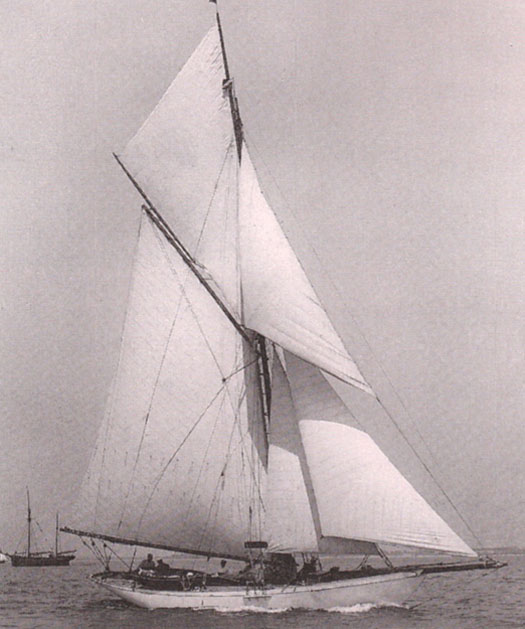
Gull at the start of the first Fastnet Race, August 15th 1925. She led overall for the first third of the race
Thus she led by a good margin going outwards past the Scillies, but with sailing power soon lessened through broken topsail halyards, the succeeding stages weren't so happy, and Jolie Brise was first to the Fastnet with time in hand on the Irish boat. Heading back towards Plymouth, a navigational error brought Gull in north of Land's End in fog, and by the time she'd made good this mistake in strong onshore winds, Jolie Brise – which was allowing her 9 hours on handicap – was well into Plymouth the winner, second went to the Royal Engineer's determinedly-sailed 38ft gaff cutter Fulmar, and third was Gull.
These days with talk (God forbid) of making the Fastnet an annual event as it is clearly so popular, we have to remember that back in the 1920s and early 30s, it took real determination to keep it going at all, first as an annual event, and then after 1931 as biennial. Certainly there were those for whom, having done the first race of 1925, doing it again was of no interest. But Harry Donegan was one of those who considered participation in the 1926 race was essential, even if he was now 56 years old and no longer in perfect health.
But the fact that he willingly took Warwick Tompkins aboard as a last-minute addition to the crew suggests that he may have had difficulty in assembling a full ship's complement back home. And the race was now acquiring further contentious issues. There were those who still said it shouldn't happen at all, but others were so enthusiastic that boats were being purpose built for the Fastnet Race. A wealthy Scot, Norman Baxendale, had commissioned William Fife to design and build a Bermudan rigged cutter which would exactly fit the Ocean Racing Club's new upper limits of LOA70ft, and LWL50ft. This was Hallowe'en, such a mighty leap forward in the concept of what constituted an ocean racer that most of the old salts considered her plain unsporting.
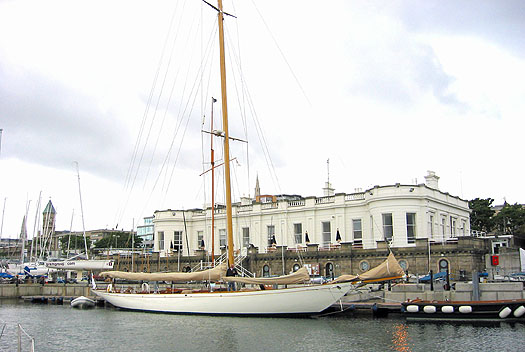
Hallowe'en, course record setter in the 1926 Fastnet Race, at the Royal Irish YC in Dun Laoghaire. Photo: W M Nixon
We know Hallowe'en so very well now, for after an adventurous life on both sides of the Atlantic, she has been restored and is currently owned by an Irish syndicate who from time to time base her at the Royal Irish YC in Dun Laoghaire, though perhaps from respect for her history, the home port inscribed on her elegant transom is Cork. But back in 1926, with a fleet of eight boats racing the second Fastnet, Hallowe'en was so much on her own that despite some strong winds as she cam in past the Lizard heading for the finish, she experienced little of the southeast gale which created mayhem out at the rock, with some boats hove to for a day and more, and Gull – which had been doing rather well, third on the water at the rock – eventually making her dramatic exit towards Cork harbour.
Hallowe'en established a course record which stood until 1939, by which time even larger boats were allowed to compete, and her times was bested by the Kriegsmarine's 88ft Gruber yawl Nordwind, whose German naval crew did not endear themselves to the organizers by their exubernant use of full uniform and Hitler salutes at the prize-giving. In fact, it wasn't until Ted Turner's 12 Meter American Eagle zapped round in style in 1971 that the Hallowe'en course record was beaten by a boat of comparable size. So back in 1926 she was sensational, yet in simply designing to the upper limits, William Fife took no other account of the developing RORC measurement rule, and Hallowe'en had a rating so stratospheric that she finished third on corrected time, the winner being the 20-ton yawl Ilex, sailed by those very determined Royal Engineers.
As for Harry Donegan and Gull, that was their last Fastnet participation, but they were regular contenders in other events, particularly the RORC Falmouth-Clyde races during the 1930s when the skipper's son Young Harry was becoming involved, and of course the skipper himself was involved with huge and infectious enthusiasm for the Irish Cruising Club from its formation in 1929.
In the end, passage races to West Cork and cruising that incomparable area became his fulfilling pleasure, and he'd a final magnificent sail from Schull back to Crosshaven before his death in 1940, aged 70. Death was with the Donegan family again all too soon, for after the war, Young Harry bought one of Cork Harbour's swiftest cruisers, the Clyde 30 Sybil. Gull was sold to the south of England where she ended her days, reportedly as a hulk in Poole Harbour. But with the exciting Sybil, the Donegan offshore racing tradition was hoped to continue, and in 1947 Young Harry and his crew brought her round to Dublin Bay for an ICC offshore race to the Clyde.
The pre-race briefing and party was in the National YC. Like his father, young Harry was a teetotaler, so he was mindful of his crew's safety as the wind was rising, and Dun Laoghaire's open harbour could be dangerously choppy for a dinghy. It proved tragically so. As they were struggling back to Sybil, the dinghy filled, and though Young Harry was heroically successful in ensuring the saving of all his shipmates, his efforts were such that he himself became exhausted, and drowned.
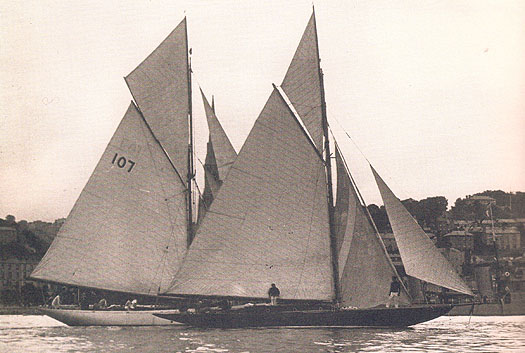
Gull (left) with the Sybil, which Young Harry Donegan bought when he sold Gull to England in 1946. Photo: Courtesy RCYC
It was a massive blow for all Irish sailing, and particularly for the Irish Cruising Club and the closely inter linked sailing community in Cork. But gradually the Donegan inspiration re-asserted itself, and the surname came to the fore in offshore racing again with the late Jim Donegan. Son of young Harry, and grandson of Henry P F Donegan, his successes with the Scampi Half Tonner Yellow Devil (with the Donegan sail number 107), the 36ft White Rooster, and lastly with the First 32s5 Mischief, put the Donegan name firmly back on the trophy boards, while in sailing administration he was the prime mover in founding SCORA (South Coast Offshore Racing Association) and, most importantly of all, in 2002 he became the first Commodore of the new Irish Cruiser Racing Association, which he founded with Fintan Cairns of Dun Laoghaire – it's now one of the most successful bodies not just in Ireland, but in offshore racing worldwide.
But now, there are many Donegans descended from the great Harry Donegan, and several of them sail. Just the same, it is quite something for young Jamie Donegan to be sailing down the Solent tomorrow on Antix, knowing that he is taking part in a globally significant event which his great-great-grandfather was instrumental in founding 88 years ago.
But in fairness, the entire Irish offshore racing community has done its bit in honouring the memory of Harry Donegan and the Gull by racing in the Fastnet as often as possible. Few more so than Denis Doyle with Moonduster, whose childhood memories of visiting the Donegan household on winter Sundays included being put to work with a junior group sanding the many wooden blocks necessary to keep Gull's huge rig under comntrol.
Then there have been other highlights such as the Irish Admirals Cup almost winning in 1979, and Ken Rohan's Regardless winning Class 1 in 1981, and Irish Independent recording the overall win in 1987 when the Admirals Cup team also notched a very creditable fourth.

Ger O'Rourke's Cookson 50 Chieftain from Kilrush sweeps in to Plymouth to win the 2007 Fastnet Race overall in convincing style.
But in the long history of the race, the supreme Irish moment has to be Ger O'Rourke's clear overall win with Chieftain in 2007. Like the rest of us, life has had its ups and downs for Ger since 2007. But that glorious supreme win is one of the greatest highlights of Irish sailing history.
So with a dozen Irish boats in the pot this year, who can we expect to figure in the final listings? Defending holder of the Gull Salver for the best-placed Irish boat in the Fastnet is the J/133 Spirit of Jacana from Carrickfergus, campaigned by the Douglas brothers, and they're going again. Much will also be expected of Antix, as her skipper is an RORC Flag Officer, and she's a proven winner. And though the Galway Reflex 38 sometimes known as Lynx has had a mixed season, over a series of events including the ICRA Championship and the Sovereigns her overall performance has been tops.
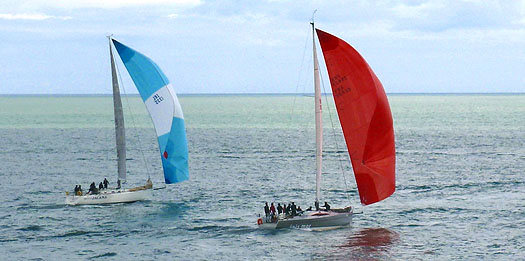
Spirit of Jacana and Inis Mor in the Round Ireland Race 2012. Both are comppeting in tomorrow's Fastnet Race. Photo: W M Nixon
More important with every year in the RORC programme is the two-handed division, and here we have a very strong interest with Andy Boyle of Dun Laoghaire who sails with Nick Martin on the J/105 Diablo-J. They won the Round Ireland Race in this division last year, and they've been right in the frame throughout this year's programme – very much a boat to watch in a division in which the competition will include young David Kenefick of Crosshaven and Olaf Sorensen of Kinsale in the Figaro II.
But with 380 boats making their westward out of the Solent tomorrow, it's anybody's guess for the class wins as much as the overall titles. So taking them alphabetically is as good as sticking in a pin hile blindfold, and here are the boats with special Irish interest, good luck to all of them.
Adelie (First 34.7, Peter Hall, NYC)
Alchimiste (JPK 9.60, Mike Murphy, KYC)
Antix (Ker 39, Anthony O'Leary, RCYC)
Aquelina (J/122, James & Sheila Tyrrell, Arklow SC)
Figaro II (Figaro, David Kenefick RCYC)
Diablo-J (J/105, Nick Martin/Andy Boyle, RORC)
Inis Mor (Ker 39, Laurent Gouy, Clifden BC),
Jedi (J/109, Andrew Sarratt, Dun Laoghaire)
Joker (J/109, Chris Andrews, Dun Laoghaire)
Lula Belle (First 36.7, Liam Coyne, NYC)
Lynx Clipper/The Gathering (Reflex 38, Aodhan Fitzgerald, GBSC),
Spirit of Jacana (J/133, Alan, Bruce & James Douglas, Carrickfergus SC.
Tonnere de Breskens (Ker 46, Piet Vroon, RORC)
#fullrirish – David Kenefick and Olaf Sorensen are completing their final preparations in Cowes to participate in the 2013 Rolex Fastnet Race. The pair are sailing David's Figaro 11 "Ilidan" IRL 45, normally recognised as "The Full Irish" when David sails the boat in the singlehanded Figaro series.
There will be eight other Figaro boats competing against them in a special division within the 300 boat fleet.
The Rolex Fastnet Race is being tracked with Yellowbrick Trackers . Each boat is supplied with a beacon from Yellowbrick, a self contained unit that transmits the position of the boat at regular intervals using GPS and Iridium (a global satellite phone network).
Synchronised position reports are availabe to the public by using the Race Player Application.
To follow David and Olaf during the race in real time just look up "Ilidan" on the race player. Aslo watch out for updates on Afloat.ie.
David has been sailing full time since October 2012 and recently completed a hectic schedule of singlehanded racing in the Figaro series when he finished as one of the top 3 rookies.
This will be Olaf's first major competitive outing in two years since he won the Dragon French Open in St Tropez in a fleet of 90 boats from 13 nations.
They start at 11.30am on Sunday and current indications suggest that they can expect a robust westerly breeze which, during the following days, will gradually become more Southerly.
It looks like they will have a long wet windward slog most of the way to the Fastnet but will then enjoy a fast downhill sleigh ride to the Finish in Plymouth.
Fastnet Challenge Cup, 300 IRC Boats Get Ready to Race
#fastnet – While the headline grabbing big boats may romp away come Sunday's start of the Rolex Fastnet Race, the world's largest offshore yacht race, a longer more intricate battle will play out between the 300 boats competing for the handicap prize, the Fastnet Challenge Cup, for the winner under IRC rating.
This year there is one obvious favourite. Niklas Zennström's Judel Vrolijk 72 Rán 2 is run with all the precision of an America's Cup team and the result has been her winning the last two Rolex Fastnet Races. The team is gunning to claim it a third time and if this pans out, Rán 2 will become the first boat to win three times in a row.
This time Rán 2 faces her stiffest competition. "It is getting tougher," acknowledges Rán 2's skipper, Tim Powell. "Obviously Bella Mente is a newer version of us. There are the VO70s which have proven to be good IRC boats. Plus with long offshore races like the Fastnet you always need an element of good fortune on your side in terms of the weather favouring your size of boat."
Journeying all the way from Australia to compete, Geoff Boettcher's Reichel Pugh 51 Secret Men's Business 3.5 is something of an unknown. Boettcher no doubt fondly remembers winning the 2010 Rolex Sydney Hobart Race, when Rán 2 finished eighth overall.
And who's looking good in the smaller classes? French boats dominated in 2011 and look to do so again. Géry Trentesaux, this year campaigning the 34ft Courrier Vintage, believes this is because: "We prefer offshore and coastal races because we compete in so many Figaros and Tour de France la Voiles."
While the French first and second placed winners in IRC 1 return in the Grand Soleil 43, Codiam, and Laurent Gouy's Ker 39, Inis Mor, the Ker 46 Tonnerre de Breskens 3 of 83-year-old Dutchman Piet Vroon is favourite. Tonnerre de Breskens 3 was overall RORC champion in 2010 and 2011 and is on track to repeat this in 2013.
"If I was a betting man I'd put my money on the 72 footers, Rán 2/Bella Mente, but it depends on what the weather is going to do," says Vroon, who won the Rolex Fastnet Race overall in 2001 with his previous 52ft Tonnerre de Breskens 3.
With an incredible 22 Rolex Fastnet Races behind him, Vroon says Tonnerre de Breskens 3 prefers more wind, but has done well in light wind too. Direct opposition comes from the Ker 40s - Edward Broadway's Hooligan VI and Andrew Pearce's Magnum III - or the French boats mentioned.
In IRC Two there is another clear favourite in Géry Trentesaux's Courrier Vintage. Paling beside Vroon's record, this will merely be Trentesaux's 12th Rolex Fastnet Race, following his first in 1977. While overall victory has eluded him, Trentesaux won his class in 2001 and 2007.
Modestly Trentesaux doesn't rate his team's chances, stating that Courrier Vintage prefers strong conditions. Instead he prefers his old boat, the First 40 La Réponse, now owned by Admiral of the RORC, Andrew McIrvine, or Michel Peretie's A-40, Stamina III, which won the class in the St Malo race or the Peter Rutter/Philippe Falle-campaigned GS43, Trustmarque Quokka 8.
In IRC Three, the top boats in the last race - the JPK 10.10s Noel Racine's Foggy Dew and Wasabi of Belgium's Vincent Willemart - this year have both lowered their rating to squeak into IRC Four. This leaves the door open to the A-35, Chenapan, or the Belgium JPK 10.10, Rackman, (fourth and fifth respectively in 2011) or the trio of top Js - Nick Martin's J/105, Diablo J, or Christopher Palmer's J-T'Aime or Todd Wells' Je Vante, two of the twenty J/109s competing. A dark horse is the JPK 10.10 Night and Day, sailed by French father and son team, Pascal and Alexis Loisin, who, despite racing doublehanded, claimed overall honours in the recent St Malo race.
According to Foggy Dew skipper Noel Racine, they detuned their JPK 10.10 to race ex-Figaro sailor Philippe Vicariot on Swinhoe and Gerard Quenot's Alkaid III in IRC Four (the three JPK 10.10s in IRC Three are racing doublehanded with bigger sails). However Racine is well aware of the threat from the smaller boats, especially Jean Yves Chateau's Nicholson 33 Iromiguy, the 2005 Rolex Fastnet Race winner. "If there is a lot of light wind at the beginning and strong wind after then the smaller boats will have the advantage."
At present it is too early to tell if the forecast will favour the big or the small boats.
Spectator Zone in Place for Start of Rolex Fastnet Race
#fastnet – Spectator craft wishing to watch the record-breaking 350+ boat fleet set off on the 608nm race will be able to do so from the safety of the Zoned area.
The two hour start sequence which runs between 1200 and 1400 will be in place from 1100 on the day.
Boats wishing to transit in and out of Cowes to the River Medina will be able to do so through the Spectator Zone which will ensure they are kept out of the way of the start line off the Royal Yacht Squadron. However, moorings are to remain clear until after the last start at 1400.
All spectator craft must observe this zone to ensure a safe start for the 45th edition of the Rolex Fastnet Race run by the Royal Ocean Racing Club.
First warning signal at 11.50 BST

